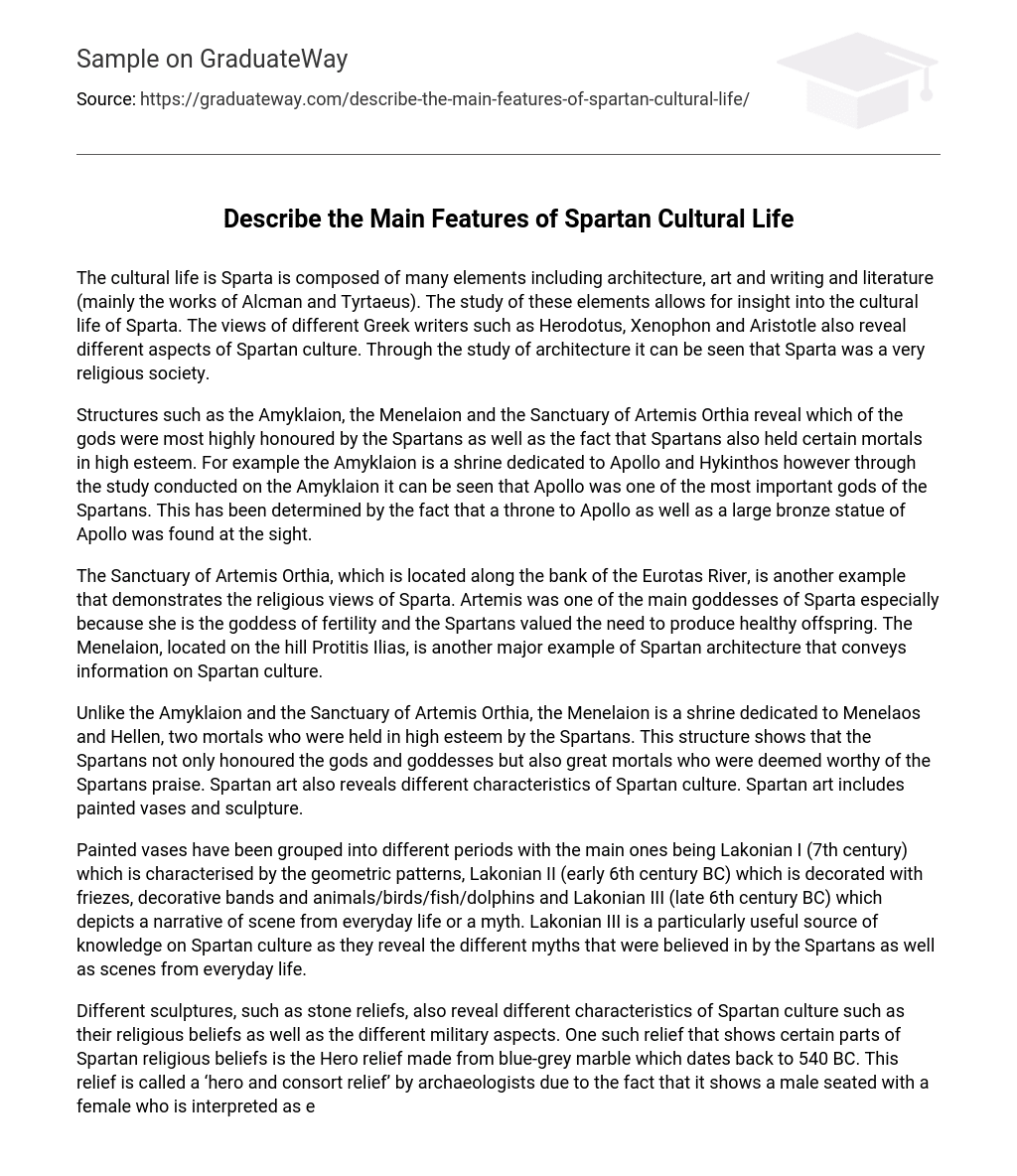The cultural life is Sparta is composed of many elements including architecture, art and writing and literature (mainly the works of Alcman and Tyrtaeus). The study of these elements allows for insight into the cultural life of Sparta. The views of different Greek writers such as Herodotus, Xenophon and Aristotle also reveal different aspects of Spartan culture. Through the study of architecture it can be seen that Sparta was a very religious society.
Structures such as the Amyklaion, the Menelaion and the Sanctuary of Artemis Orthia reveal which of the gods were most highly honoured by the Spartans as well as the fact that Spartans also held certain mortals in high esteem. For example the Amyklaion is a shrine dedicated to Apollo and Hykinthos however through the study conducted on the Amyklaion it can be seen that Apollo was one of the most important gods of the Spartans. This has been determined by the fact that a throne to Apollo as well as a large bronze statue of Apollo was found at the sight.
The Sanctuary of Artemis Orthia, which is located along the bank of the Eurotas River, is another example that demonstrates the religious views of Sparta. Artemis was one of the main goddesses of Sparta especially because she is the goddess of fertility and the Spartans valued the need to produce healthy offspring. The Menelaion, located on the hill Protitis Ilias, is another major example of Spartan architecture that conveys information on Spartan culture.
Unlike the Amyklaion and the Sanctuary of Artemis Orthia, the Menelaion is a shrine dedicated to Menelaos and Hellen, two mortals who were held in high esteem by the Spartans. This structure shows that the Spartans not only honoured the gods and goddesses but also great mortals who were deemed worthy of the Spartans praise. Spartan art also reveals different characteristics of Spartan culture. Spartan art includes painted vases and sculpture.
Painted vases have been grouped into different periods with the main ones being Lakonian I (7th century) which is characterised by the geometric patterns, Lakonian II (early 6th century BC) which is decorated with friezes, decorative bands and animals/birds/fish/dolphins and Lakonian III (late 6th century BC) which depicts a narrative of scene from everyday life or a myth. Lakonian III is a particularly useful source of knowledge on Spartan culture as they reveal the different myths that were believed in by the Spartans as well as scenes from everyday life.
Different sculptures, such as stone reliefs, also reveal different characteristics of Spartan culture such as their religious beliefs as well as the different military aspects. One such relief that shows certain parts of Spartan religious beliefs is the Hero relief made from blue-grey marble which dates back to 540 BC. This relief is called a ‘hero and consort relief’ by archaeologists due to the fact that it shows a male seated with a female who is interpreted as either the wife, partner or consort of the male.
The male is identified as a hero due to the snake that rises up on the back of the seat. This is so as the Greeks believed that the snakes in graveyards had come from the marrow of the bones of heroes. It is also believed by historians and archaeologists that the underworld is signified by the veil that is held by the woman above her head. The two-handled cup being held by the male signifies feasting in the afterlife and thus it is believed that the couple has a happy position in the underworld. This relief shows one view that the Spartans had of the afterlife as well as their heroes.
Spartan writing and literature, particularly those of Alcman and Tyrtaeus, also provide different information about different traits of Spartan culture. Alcman, for example, in his works describes the natural beauty of Sparta and also wrote poetry that was to be sung in the maiden chorus. Through his work, one is able to gain a clear image of the Spartan region and through his works for the maiden chorus, one can also learn of the different festivities of that time as well as the type of poetry and narratives that were to be sung at such festivities.
Alcman’s poetry for the maiden chorus also reveals religious views of the Spartans such as the gods that were highly honoured by the Spartans. Tyrtaeus was a ‘soldier poet’ of Sparta and, as such, wrote poetry that was sung by men and especially by those within the army. His poetry reveals the fundamental themes such as patriotism, courage and honour that were important to the Spartans as well as the values held by the Spartan soldiers such as that honour would come to those who were brave in battle and disgrace to those who were cowardly.
His poetry also reveals the key virtues that were desired for the young boys of Sparta to attain: courage, discipline and manliness. The views of different Greek writers provide us with different views on the Spartan culture. Herodotus, for example, is critical of Sparta and its constitution but also provides information on Sparta’ military prowess. Xenophon is a great admirer of Sparta and her traditions and provides details on the Spartan military system, social customs and law. Aristotle is, like Herodotus, critical of the Spartan constitution as well as the women of Sparta.
It is through the views of these Ancient historians that one can see how very culturally different (especially in regards to their women and military goal/customs) Sparta was to the other Greek states. Therefore it can be seen that through the study of the different aspects of Sparta such as Spartan architecture, art, writing and literature and as well as the views of Greek writers that one is able to learn about different characteristics of Spartan culture such as the religious views of Sparta as well as the importance of their military.





